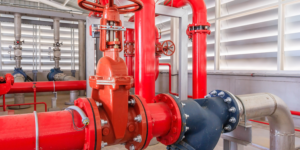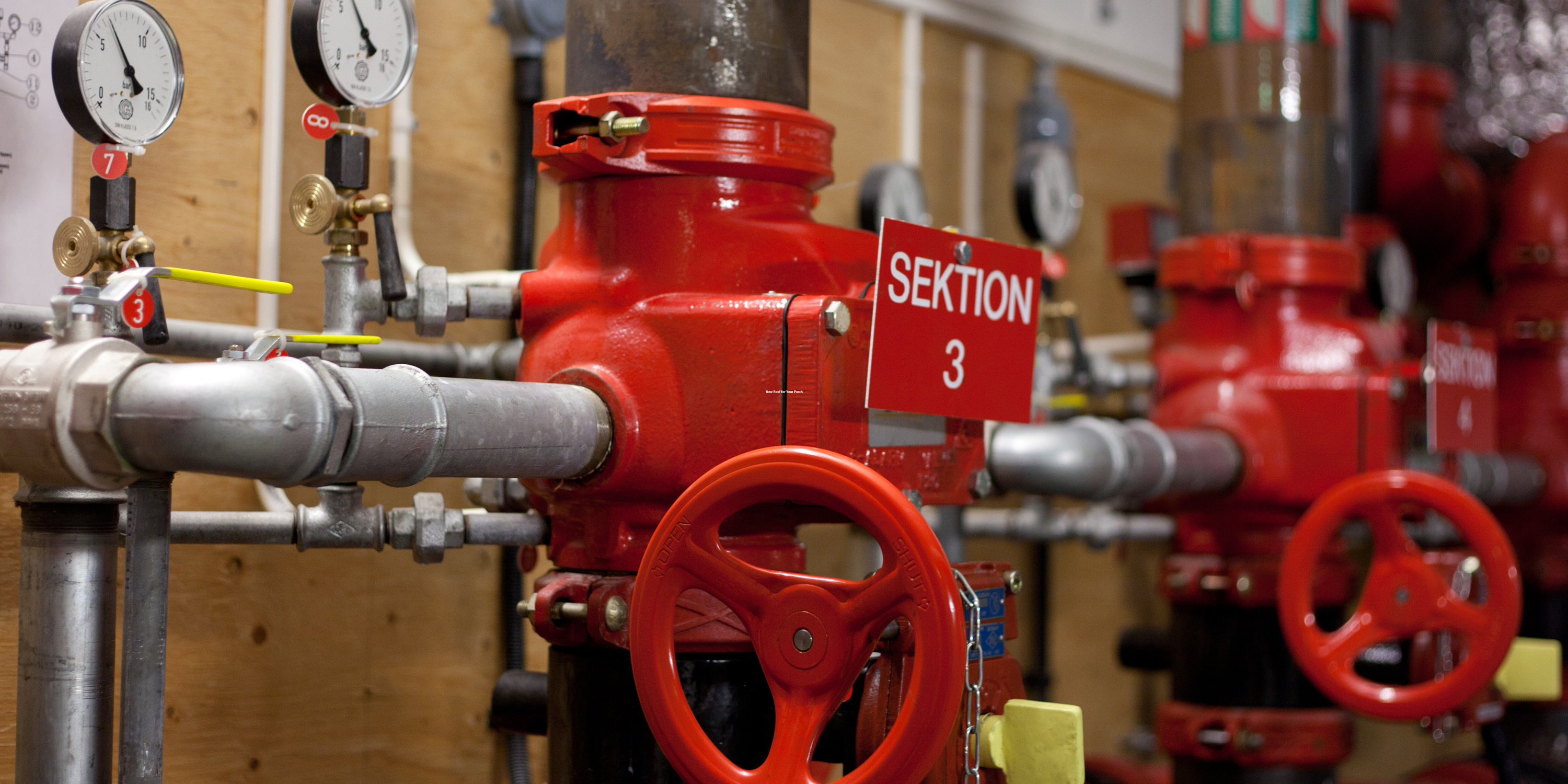A spark starts a room on fire in seconds. A competent fire suppression system can prevent catastrophic loss in this scary scenario. Fire sprinklers are essential to any fire protection plan, but how do they work? How do these ordinary devices become life-saving superheroes in an instant?
We’ll explain fire sprinkler activation science and cover their components, types, effectiveness, and maintenance.
Components of a Fire Sprinkler System
Fire sprinkler systems use several critical components to detect and fight flames. Water supply, pipes, sprinkler heads, and control valves are included. Water is the system’s heart. A municipal water line or dedicated water tank usually supplies it. For fire emergencies, this ensures enough water.
The building’s pipes carry pressurized water from the source to the sprinkler heads. Steel or CPVC are used to endure high pressure and heat. Sprinkler heads cover certain rooms and are strategically distributed throughout the building. The deflector plate disperses water in a precise manner when heated.
Control valves regulate system water flow. They can be manual or automatic and isolate portions for maintenance or shut off sprinklers.
Together, these components form a network that detects and suppresses flames quickly. Heat activates sprinklers, which release pressure water onto the fire below, containing it until aid arrives.
Types of Fire Sprinkler Systems
Different fire sprinkler systems can be installed depending on a building’s demands. Unique qualities and benefits distinguish each variety. Wet pipe systems are prevalent. In this method, water is always in the pipes, allowing speedy fire response. Water immediately flows via sprinklers activated by heat to extinguish fires.
Dry pipe systems exist also. Until heat detectors or manual release stations activate them, these systems contain compressed air or nitrogen. This device rapidly releases compressed air from pipes, allowing water to flow into them and onto the flames. Reaction systems are utilized in structures where unintentional activation could cause considerable damage. These systems require smoke detectors and heat-sensitive parts to activate before water enters the piping network.

Deluge systems are common in hazardous places like chemical storage and power stations. In contrast to other systems, deluge systems release a lot of water in a particular area when a sensing device triggers them. The type of fire sprinkler system installed depends on building occupancy classification and potential dangers. To secure your property, talk with life-saving system designers and installers!
How Do Fire Sprinklers Work?
Sprinkler systems are essential to structure fire safety. Have you wondered how lifesaving gadgets work? Explore fire sprinkler activation science. The trigger mechanism of every fire sprinkler is a small glass bulb or metal fusible link loaded with heat-sensitive liquid. This liquid expands and breaks the bulb or melts the connection, releasing water when exposed to fire heat.
When and where water is distributed depends on the sprinkler head design. The water flow from each sprinkler head is deflected to heat and flame-prone locations. This maximizes extinguishment while reducing water damage to unaffected areas. Fire alarms do not trigger all sprinklers at once, contrary to popular perception. Each sprinkler functions according to its own temperature. This localized response implies only excessive heat zones will receive water.
Due to their quick response time, fire sprinklers function quickly. After exceeding their activation temperature threshold, they discharge water within minutes or seconds of measuring excessive heat. Room size and ceiling height also affect how quickly fire sprinklers activate throughout a place. Multiple strategically placed heads may be needed for better coverage and faster response times in larger rooms or warehouses.
The sprinkles in the building operate individually based on local conditions, contrary to movies and TV shows!
The Role of Heat in Activating Fire Sprinklers
Heating activates fire sprinklers, saving lives. Fire sprinklers respond to fire heat, unlike in movies when a single open flame activates the system. A small glass bulb or metal link filled with heat-sensitive liquid is within each sprinkler head. This part is the sprinkler “trigger”. The liquid inside expands and bursts through the bulb or melts the connection as adjacent flames heat it.
Activated sprinkler heads release water to extinguish flames. Only the sprinklers nearest to the heat source will activate, leaving others unaffected unless more areas catch fire. This selective activation directs water into or around burning items, reducing spread and minimizing damage.
Precision engineering prevents fire sprinklers from activating when there is no hazard. The activation threshold is usually high enough to prevent accidental activation during daily activities like cooking or smoking.
Factors Affecting Fire Sprinkler Activation Time
Every second matters in fire safety. Fire sprinklers must activate immediately in a fire. However, various factors affect fire sprinkler activation time. Heat source type matters. varying materials burn at varying temperatures and rates, affecting fire propagation and sprinkler activation. Small electrical fires may take longer to trigger sprinklers than grease fires.
Sprinkler head positioning also affects activation time. Blockages to flame contact or excessive distance between sprinkler heads may delay their response. Also important are maintenance and inspections. Regular checkups verify that all components are working properly and that no system blockages are preventing water flow.
Building size and design might also affect activation time. Larger structures may need more plumbing or water pressure to cover all regions. Weather and power outages can delay activation. Extreme cold or power outages might disrupt water flow or automatic detection systems.
Understanding these aspects emphasizes the significance of regular maintenance, correct installation, and scenario analysis when constructing a reliable fire protection system.
Common Misconceptions about Fire Sprinklers
Fire sprinkler systems have been around for decades, yet myths about their usefulness and operation persist. Debunk some of these myths.
- “All the sprinklers in a building will go off at once.”
This is one of the biggest fire sprinkler myths. The sprinkler heads run independently based on heat detection. Only close fire sprinklers activate, reducing water damage to unaffected areas. - “Water damage from sprinklers is worse than fire damage.”
Water can cause damage, especially if not addressed, but an uncontrolled fire is worse. Fire sprinklers put out fires before they spread and cause damage. - “Smoke detectors are enough; I don’t need fire sprinklers.”
Smoke detectors warn residents of a fire hazard but do little to halt the flames. For safety, combine smoke detectors and fire sprinkler systems for early warning and active suppression. - “Fire sprinkler systems are expensive and difficult to maintain.”
Modern advances have made fire sprinkler systems cheaper than ever, yet installation prices vary by building size and configuration. It is also easy when specialists do routine maintenance and ensure all components work properly. - “Fire can be easily controlled with portable extinguishers alone.”
Extinguishers are useful in early firefighting; however, sprinkler systems provide faster and more reliable automated fire protection. - “Fire sprinklers can accidentally go off due to high temperatures or smoke from cooking.”
Modern fire sprinkler systems have temperature and smoke-sensing thresholds to prevent false alarms from high heat or smoke-activating sprinkler heads. Cooking near a sprinkler head should not activate it unless there is a fire.
Fire sprinkler capabilities and benefits should be researched so you may make informed decisions to protect your property and occupants. Remember, properly installed and maintained fire sprinkler systems save lives and decrease property damage.
Advantages and Effectiveness of Fire Sprinkler Systems
Fire sprinkler systems are one of the best ways to manage and suppress flames in homes and businesses. These devices have many benefits that make them crucial to fire safety plans. Fire sprinklers typically detect fires before they spread or cause considerable damage. Early discovery provides for a quick response, reducing damage and death.
Fire sprinkler systems are fast and effective at extinguishing flames. When a heat source is detected, the nearest sprinkler head releases water directly onto the fire. To prevent flames from spreading throughout the building, act immediately. After heat activates them, fire sprinklers work automatically, unlike extinguishers or hoses. These technologies will contain and extinguish fires even if no one is present.

Additionally, fire sprinklers utilize much less water than previous firefighting methods. These technologies limit property damage and maximize firefighting efficiency by targeting specific heat and flame-affected locations rather than dousing a complete area with water. Studies demonstrate that buildings with properly installed and maintained fire sprinkler systems have fewer fatalities. Emergency evacuation is much safer with reliable automated suppression.
Finally, and significantly, insurance companies understand fire sprinklers’ importance in reducing fire damage. Many insurers give lower premiums for buildings with functional and well-maintained sprinkler systems, demonstrating their effectiveness and long-term cost savings.
Proper Maintenance and Care for Fire
Fire sprinkler systems need adequate maintenance to work properly. Regular inspections by authorized personnel can detect system deterioration and faults. These inspections usually check the water supply, alarm valves, pipes for corrosion or leaks, sprinkler heads for obstructions, and all components for functionality.
Regular inspections and normal maintenance including cleaning sprinkler heads and replacing broken or expired parts are essential. Debris and other obstructions should also be removed from sprinkler areas.
Fire sprinkler emergencies should also be planned for. This involves instructing tenants on fire safety and providing simple access to shut-off valves in case of accidental activation.
Property owners can enhance fire sprinkler system lifespan and efficiency by following certain maintenance procedures and being proactive. Doing so saves lives and valuables from fires.
